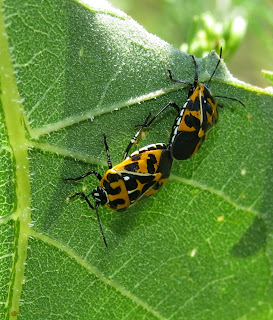It is a pity that the Harlequin Bug, Murgantia histrionica, is widely regarded as an agricultural and garden pest. This member of the stink bug family Pentatomidae is easily one of our most colorful North American insects. I know, I know, tell that to the cabbage farmer.
The fact that I rarely come across this species probably colors my opinion of it toward the rose end of the spectrum. Recently, a contributor to the "Arthropods Colorado" Facebook group page posted images of them in large numbers, so clearly they can be overly abundant at times, in certain places, on certain plants.
The Harlequin Bug is not even native, having moved here from Mexico and Central America (now, now, no illegal immigrant jokes). It was first recorded in the U.S. in Washington County, Texas in 1864, and has since spread northward. Today, it ranges from New England south and west to Colorado, Arizona, and southern California. There have been sporadic records of M. histrionica in northern Illinois, Minnesota, Iowa, and South Dakota.
The adult insect measures 8-11.5 millimeters, and is patterned in black and orange, red, or yellow. Interestingly, I found the specimens in southern California to be almost totally black compared to populations elsewhere, like here in Colorado.
The bright "warning colors," called aposematism in scientific circles, serve notice to potential predators that ingesting the animal wearing that wardrobe could cause sickness or even death.
Like all stink bugs, the Harlequin Bug can secrete aromatic compounds from glands in the thorax when the insect feels threatened. Additionally, Murgantia backs up that warning with toxins that make it very distasteful, especially to birds. Harlequin Bugs feed on a variety of plants, but are partial to those in the mustard family. The bugs take in glucosinolates from those plants as they feed, then use those chemicals for their own defense in a process known as sequestration. Essentially, the bug is unaffected by the plant's chemical defenses, and even hijacks those poisons for its own defense.
Harlequin Bugs do two things very well: eat, and make more Harlequin Bugs. The female bug lays clusters of about a dozen stunning black-and-white banded, barrel-shaped eggs on the host plant. She can lay several clutches in her lifetime, about every three days starting ten days into her adult stage.
Soon, tiny little nymphs emerge from those eggs, disperse, and begin feeding. The nymphs go through five instars (an instar is the interval between molts) before becoming adults. It takes an average of 48 days from egg to adult under laboratory conditions, at an average temperature of 77° F. There may be 3-4 generations of the bug annually, only two in the northern reaches of its range, but up to eight in southernmost latitudes.Adult females live an average of 41 days, while males endure for around 25. Apparently, the sexes find each other in part from vibrational signals they send through the stems and foliage of the plants they are sitting on.
Murgantia histrionica is not completely invincible. The eggs are attacked by a number to tiny parasitic wasps, namely Ooencyrtus johnsoni, Trissolcus murgantiae, T. basalis, and other Trissolcus species. The Wheel Bug, Arilus cristatus, will prey on the nymphs of the Harlequin Bug, as will the sand wasp Bicyrtes quadrifasciata, the female wasp paralyzing stink bugs as food for her larval offspring in an underground burrow.
Judging by the extraordinary abundance of this species in Colorado this year, I would say the Harlequin Bug prospers in wet years. The preceding years here have been extremely dry, and that may account for their scarcity until now.
Sources: Aliabadi, Alireza, J. Alan A. Renwick, and Douglas W. Whitman. 2002. "Sequestration of Glucosinolates by Harlequin Bug Murgantia histrionica," J. Chem. Ecol. 28(9): 1749-1762.
Canerday, T. Don. 1965. "On the Biology of the Harlequin Bug, Murgantia histrionica (Hemiptera: Pentatomidae)," Ann. Entomol. Soc, Am. 58(6): 931-932.
McPherson, J.E. 1982. The Pentatomoidea (Hemiptera) of Northeastern North America With Emphasis on the Fauna of Illinois. Carbondale: Southern Illinois University Press. 240 pp.
Zahn, Deane K., Robbie D. Girling, J. Steven McElfresh, Ring T. Cardé, and Jocelyn C. Millar. 2008. "Biology and Reproductive Behavior of Murgantia histrionica (Heteroptera: Pentatomidae)," Ann. Entomol. Soc. Am. 101(1): 215-228.








No comments:
Post a Comment
Blog author currently unable to reply to reader comments, nor comment himself. Working to resolve this.